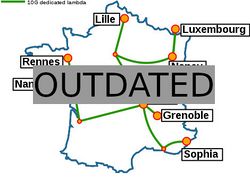Grid5000:Home: Difference between revisions
No edit summary |
No edit summary |
||
| Line 7: | Line 7: | ||
Key features: | Key features: | ||
* provides '''access to a large amount of resources''': 15000 cores, 800 compute-nodes grouped in homogeneous clusters, and featuring various technologies: GPU, SSD, NVMe, 10G and 25G Ethernet, Infiniband, Omni-Path | * provides '''access to a large amount of resources''': 15000 cores, 800 compute-nodes grouped in homogeneous clusters, and featuring various technologies: PMEM, GPU, SSD, NVMe, 10G and 25G Ethernet, Infiniband, Omni-Path | ||
* '''highly reconfigurable and controllable''': researchers can experiment with a fully customized software stack thanks to bare-metal deployment features, and can isolate their experiment at the networking layer | * '''highly reconfigurable and controllable''': researchers can experiment with a fully customized software stack thanks to bare-metal deployment features, and can isolate their experiment at the networking layer | ||
* '''advanced monitoring and measurement features for traces collection of networking and power consumption''', providing a deep understanding of experiments | * '''advanced monitoring and measurement features for traces collection of networking and power consumption''', providing a deep understanding of experiments | ||
Revision as of 23:57, 11 February 2020
|
Grid'5000 is a large-scale and flexible testbed for experiment-driven research in all areas of computer science, with a focus on parallel and distributed computing including Cloud, HPC and Big Data and AI. Key features:
Grid'5000 is merging with FIT to build the SILECS Infrastructure for Large-scale Experimental Computer Science. Read an Introduction to SILECS (April 2018)
Older documents:
|
Random pick of publications
Five random publications that benefited from Grid'5000 (at least 2924 overall):
- Mateusz Gienieczko, Filip Murlak, Charles Paperman. Supporting Descendants in SIMD-Accelerated JSONPath. International Conference on Architectural Support for Programming Languages and Operating Systems (ASPLOS 2024), 2024, San Diego (California), United States. pp.338-361, 10.4230/LIPIcs. hal-04398350 view on HAL pdf
- Céline Acary-Robert, Emmanuel Agullo, Ludovic Courtès, Marek Felšöci, Konrad Hinsen, et al.. Guix-HPC Activity Report 2022–2023. Inria Bordeaux - Sud Ouest. 2024, pp.1-32. hal-04500140 view on HAL pdf
- Alexandre Sabbadin, Tom Guérout. Towards a Classification of Edge Service Orchestration Strategies Integrating Renewable Energy. 22nd International Conference on Service-Oriented Computing (ICSOC 2024), Dec 2024, Tunis (Tunisie), Tunisia. hal-05010531 view on HAL pdf
- Bruno Lévy, Nicolas Ray, Quentin Merigot, Hugo Leclerc. Large-scale semi-discrete optimal transport with distributed Voronoi diagrams. Journal of Computational Physics, 2025, pp.114374. 10.1016/j.jcp.2025.114374. hal-05253830 view on HAL pdf
- Antoine Franchini, Stéphane Girard, Anne Dutfoy. Adaptive confidence intervals for extreme quantiles from heavy-tailed distributions. 2025. hal-05322341 view on HAL pdf
Latest news
Failed to load RSS feed from https://www.grid5000.fr/mediawiki/index.php?title=News&action=feed&feed=atom: Error parsing XML for RSS
Grid'5000 sites
Current funding
As from June 2008, Inria is the main contributor to Grid'5000 funding.
INRIA |
CNRS |
UniversitiesUniversité Grenoble Alpes, Grenoble INP |
Regional councilsAquitaine |


